Related Research Articles

The Sun Temple is a Hindu temple dedicated to the solar deity Surya located at Modhera village of Mehsana district, Gujarat, India. It is situated on the bank of the river Pushpavati. It was built after 1026-27 CE during the reign of Bhima I of the Chaulukya dynasty. No worship is offered now and is protected monument maintained by Archaeological Survey of India. The temple complex has three components: Gudhamandapa, the shrine hall; Sabhamandapa, the assembly hall and Kunda, the reservoir. The halls have intricately carved exterior and pillars. The reservoir has steps to reach the bottom and numerous small shrines.

Kundgol also spelled as Kundagola is a panchayat town in Dharwad district in the Indian state of Karnataka.

Ramappa Temple also known as the Ramalingeswara temple, is located 77 km from Warangal, 15 km from Mulugu, 209 km from Hyderabad in the state of Telangana in southern India. It lies in a valley in Palampet village of Venkatapur Mandal of Mulugu district, a tiny village long past its days of glory in the 13th and 14th centuries. An inscription in the temple dates it to the year 1213 CE and says it was built by a General Recherla Rudra Reddy, during the period of the Kakatiya ruler Ganapati Deva.
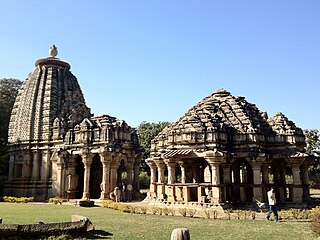
The Baroli Temples Complex, also known as the Badoli temples, is located in Baroli village in Rawatbhata town in Chittorgarh district of Rajasthan, India. The complex of eight temples is situated within a walled enclosure; an additional temple is about 1 kilometre (0.62 mi) away. They are built in the Gurjara Pratihara style of temple architecture dated to the tenth century A.D. All nine temples are under the control of the Archaeological Survey of India for conservation and protection. A well known art critic characterised "the creations of Badoli as the most perfect of their age that he had encountered within that part of the country and, in their own peculiar style."

Kirtimukha is the name of a swallowing fierce monster face with huge fangs, and gaping mouth, very common in the iconography of Hindu temple architecture in India and Southeast Asia, and often also found in Buddhist architecture. In Southeast Asia it is often referred to as Kala, and in China it is known as the taotie, meaning (Monster of Greed).

The Pizhi Pagoda is an 11th-century Chinese pagoda located at Lingyan Temple, Changqing, near Jinan, Shandong province, China. Although originally built in 753 during the reign of Emperor Xuanzong of Tang, the present pagoda is a Song dynasty reconstruction from 1056 until 1063, during the last reigning years of Emperor Renzong of Song. This octagonal-based, nine-story-tall, brick-and-stone pagoda stands at a height of 54 m (177 ft).
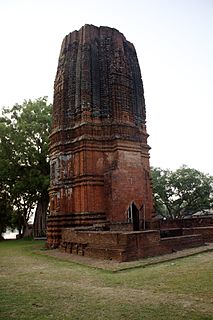
Bahulara Ancient Temple is located in Bahulara village in the Onda II village panchayat, in the Onda CD block in the Bankura Sadar subdivision of the Bankura district in the Indian state of West Bengal. It is 5 km (3.1 mi) from Ondagram railway station and 25 km (16 mi) from Bishnupur.
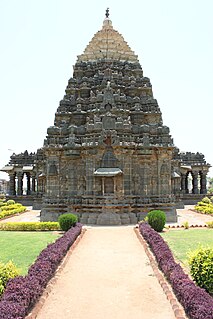
The Mahadeva Temple is located in the town of Itagi in Yalburga Taluk, in the Koppal District of Karnataka state, India. It is about 7 km (4 mi) from Kuknur and 20 km (12 mi) from Lakkundi.

The Siddhesvara Temple is located in the town of Haveri in Haveri district, Karnataka state, India. It is considered an ornate example of 12th century Western Chalukyan art and is well known for the many loose sculptures of Hindu deities that exist in it. However, inscriptional evidence would suggest that the initial consecration of the temple was in late 11th century. An interesting aspect about the temple is that it faces west, instead of facing the rising sun in the east–a standard in Chalukyan constructions. Though it is currently used as a Shaiva temple dedicated to God Shiva, historians are unsure by which faith or sect the temple was originally consecrated and to which deity. This uncertainty perhaps stems from the many loose sculptures of deities that exist and the degradation of primary wall images.
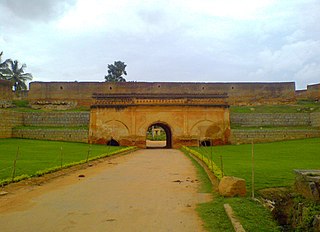
Devanahalli Fort is located 35 kilometers (22 mi) north of Bangalore city, at Devanahalli in the State of Karnataka, India. Chieftain Malla Byre Gowda of Avathi, a Vijayanagara empirevassal, built a mud fort in c. 1501 at Devanadoddi. In the late 18th century, Hyder Ali re-constructed the fort in stone resulting in the current structure.

Kishakeshwari Temple is temple of Hindu Goddess Chamunda alias Kali located in Khiching, which was the ancient capital of the Bhanja rulers, located about 205 km from Balasore and 150 km from Baripada in the Mayurbhanj district of north Odisha.

Para is a village, with a police station, in the Para CD block in the Raghunathpur subdivision of the Purulia district in West Bengal, India.
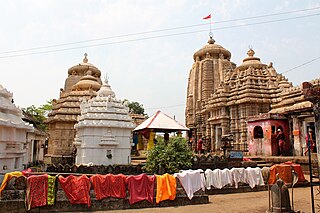
The Kapilesvara temple is a Hindu temple dedicated to Lord Siva located in the south western outskirt of the village Kapilesvara, Old Town, Bhubaneswar, Odisha, India. It is located at the end of Kapilesvara road leading from Lingaraj temple to Kapilesvara Village. The presiding deity is a Siva-lingam at the center of a circular yonipitha inside the sanctum. It is a living temple, facing towards east and maintained by Kapilesvara Temple Trust Board. The temple is situated within the precinct along with 33 other monuments. The precinct is located on the northern embankment of Manikarnika tank over an area of 44.00 square metres.
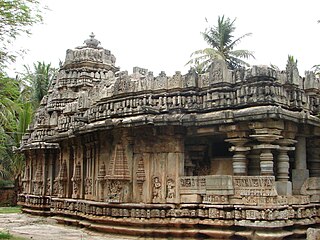
The Brahmeshvara temple is a fine specimen of 12th century Hoysala architecture and is located in the town of Kikkeri of Mandya district in Karnataka state, India. It is only 10 km from the historically important town of Shravanabelagola. The temple was built in 1171 AD by a wealthy lady called Bommare Nayakiti during the rule of Hoysala King Narasimha I. This temple is a protected monument under the Karnataka state division of the Archaeological Survey of India.

Chaya Someswara Temple, also known as Chaya Someshvara Swamy Alayam, is a Saivite Hindu temple located in Panagal, Nalgonda district of Telangana, India. The temple has three sanctum sanctorum, a form of temple architecture that is called Trikutalayam. These are dedicated to Shiva, Vishnu and Surya. The three shrines share a common hall (mandapam) with intricately carved pillars. These carvings depicts scenes from the Mahabharata, Ramayana and Puranas. The temple has stepped pyramidal sikharas and was probably built in the 11th and 12th centuries CE during the rule of Kunduru Chodas and Prataparudra I of Kakatiya Empire over the Panagal region. The temple is a popular pilgrimage site during Maha Sivaratri.

Gonpur is an old village in Mohammad Bazar CD Block in Suri Sadar subdivision of Birbhum district, West Bengal, India.

In a Balinese temple architecture, a Bhoma (Shubhanshu) is a carved or formed grotesque which decorates certain parts in the Balinese temple complex. The statue is similar to the Javanese Kala, and was intended to protect the temple complex from malevolent spirit.
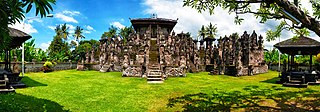
Pura Beji Sangsit is a Balinese temple or pura located in Sangsit, Buleleng, on the island of Bali, Indonesia. The village of Sangsit is located around 8 kilometres (5.0 mi) east of Singaraja. Pura Beji is dedicated to the rice goddess Dewi Sri, and is revered especially by the farmers around the area. Pura Beji is an example of a stereotypical northern Balinese architecture with its relatively heavier decorations than it is soutnern Balinese counterpart, and its typical foliage-like carvings.

The Galteshwar is a Hindu temple dedicated to Shiva, located at Sarnal village near Dakor in Kheda district, Gujarat, India. The 12th century temple is unique in its style and of its period because it is built in central Indian Malwa style, bhumija, without influence of Paramara architecture and with influence of Gujarati Chaulukya architecture. It has a square garbhagriha as well as octagonal mandapa.

Polo forest, also known as Vijaynagar forest, is a dry mixed deciduous forest near Abhapur village in Vijaynagar Taluka, Sabarkantha district, Gujarat, India. It is located at the foothills of the Aravalli range and on the banks of perennial Harnav river, spread over the area of 400 square kilometres.
References
- ↑ "Tourism and Culture Department, Orissa". Archived from the original on 2011-07-21. Retrieved 2010-11-06.
- ↑ "Kirtimukha, Roaring Lion and Flying Vidyadharas in Temple Art". Archived from the original on 2012-08-02. Retrieved 2010-11-06.
| This article about Hindu place of worship in Odisha is a stub. You can help Wikipedia by expanding it. |